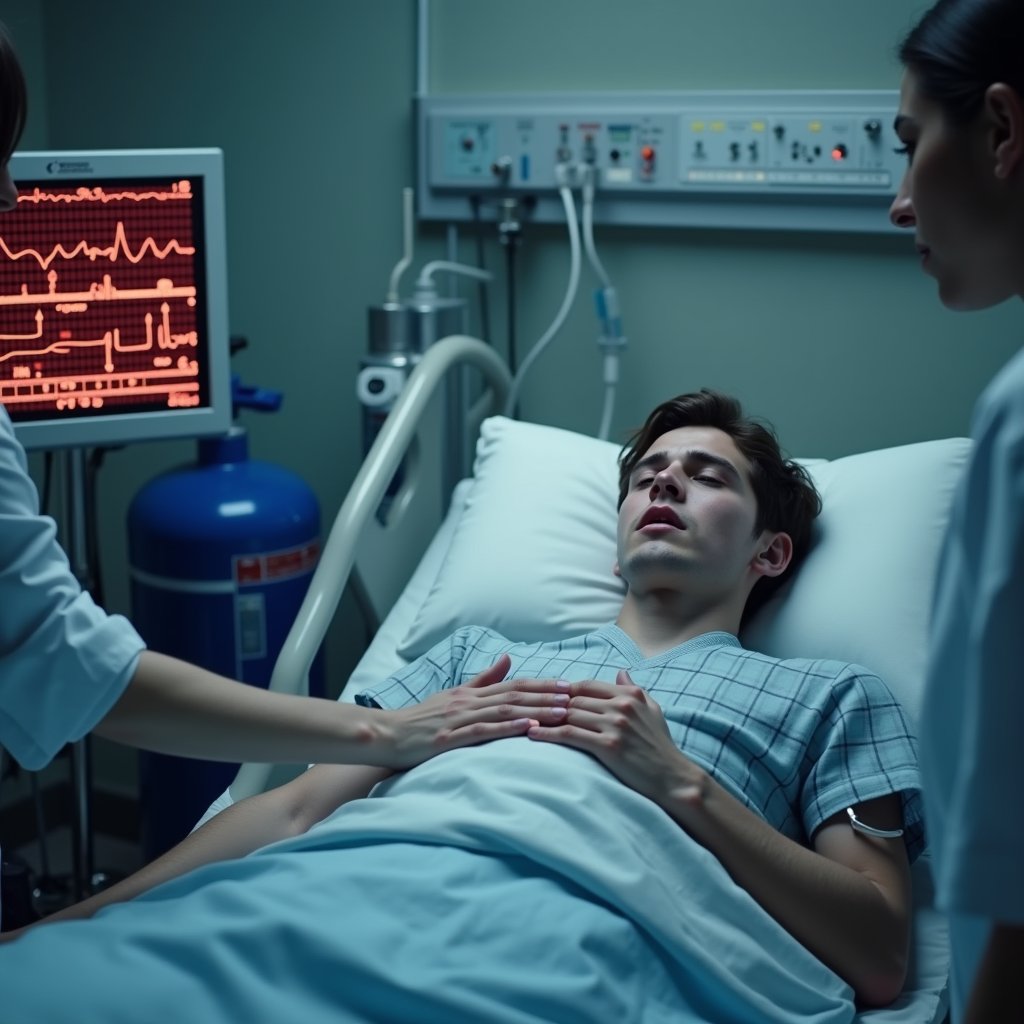Ten urgent risks of nitrous oxide include rapid oxygen depletion, dangerous spikes in blood pressure, permanent nerve damage, and severe vitamin B12 depletion. You’ll face immediate respiratory dangers like pulmonary overdistension and pneumothorax, along with cardiac strain that’s worse with stimulants. Watch for neurological symptoms including unsteady gait and visual disturbances. Asian populations show increased susceptibility to these effects. Understanding the full scope of these risks could prevent life-threatening complications.
Critical Respiratory Complications From Nitrous Oxide Exposure

While nitrous oxide remains a widely used anesthetic agent, its administration carries significant respiratory risks that demand careful clinical consideration. You’ll need to monitor closely for pulmonary overdistension patterns, as N₂O can rapidly expand existing pneumothorax and pulmonary bullae, potentially leading to rupture and systemic complications. When administered properly, safe nitrous use allows patients to remain conscious and responsive to medical instructions during procedures. For optimal clinical outcomes, doctors rely on evidence-based reviews from medical experts who evaluate safety protocols. The presence of toxic impurities like NO, NO2, CO, and NH3 in nitrous oxide cylinders can lead to severe complications.
Rapid gas expansion dangers are particularly concerning in patients with pre-existing respiratory conditions. If you’re treating someone with COPD or chronic respiratory issues, N₂O is absolutely contraindicated due to the risk of exacerbating their condition. You must also watch for signs of respiratory irritation, laryngospasm, and impaired gas exchange. The presence of NO/NO₂ impurities can cause sudden cyanosis, while improper administration may trigger reflex breathing inhibition and mucosal damage in the upper airway tract.
Immediate Cardiac Risks During Recreational Use

When you use nitrous oxide recreationally, you’ll experience immediate changes in your heart rate and blood pressure within seconds of inhalation. Your cardiovascular system responds with an initial spike in heart rate followed by a rapid drop, creating potentially dangerous fluctuations in cardiac rhythm. These risks become significantly worse when combining nitrous oxide with stimulants, as it can create dangerous heart strain. Your blood pressure typically follows a similar pattern of acute elevation then depression, which can strain your heart muscle and coronary vessels, particularly if you have any underlying cardiac conditions. These risks become especially severe when nitrous oxide causes hyperhomocysteinemia and thrombosis, leading to potential blood clot formation in the coronary arteries.
Acute Heart Rate Changes
Recreational nitrous oxide exposure triggers immediate and significant cardiac changes, with users experiencing heart rate increases within 15 minutes of administration. You’ll notice peak cardiovascular effects between 15-30 minutes, with extreme oxygen depletion potential increasing your sudden cardiac events risk. These changes can persist longer during recreational use compared to controlled medical settings. Scientific evidence from the ENIGMA-II trial demonstrates safe cardiovascular outcomes when used properly in medical settings under physician supervision. Medical professionals may administer supplemental oxygen to prevent complications.
| Time Period | Heart Response | Risk Level |
|---|---|---|
| 0-15 min | Rapid increase | Moderate |
| 15-30 min | Peak effects | Severe |
| 30-60 min | Variable recovery | High |
If you’re combining nitrous oxide with other substances, particularly stimulants or cannabis, you’re facing amplified cardiovascular strain. Your heart rate may remain increased beyond the typical 45-60 minute recovery window, especially if you’re engaging in repeated use or improper administration techniques that restrict oxygen supply.
Blood Pressure Impact Patterns
Because nitrous oxide directly suppresses cardiovascular function, you’ll experience dramatic blood pressure fluctuations within minutes of exposure. Your body’s hypertension regulation becomes severely compromised, especially when combining nitrous oxide with stimulants or cannabis.
These interactions can trigger dangerous spikes in blood pressure, increasing your risk of arterial gas embolism and acute cardiac events.
You’re particularly vulnerable to rapid pressure changes if you’re inhaling pure nitrous oxide, which displaces oxygen and forces your heart to work harder. The resulting hypoxia can lead to compensatory hypertension followed by dangerous hypotensive shock.
When mixed with cocaine or amphetamines, you’ll face an even greater risk of life-threatening blood pressure surges that can culminate in arrhythmias or myocardial infarction.
Severe Neurological Symptoms and Warning Signs

The severe neurological symptoms associated with nitrous oxide abuse typically manifest through a complex combination of motor, sensory, and autonomic dysfunction. You’ll notice progressive neurological decline through muscle weakness in your limbs, unsteady gait, and hyperactive reflexes. Watch for impaired vibratory sensation and proprioceptive issues that affect your balance and coordination. The immediate administration of hydroxocobalamin treatment is crucial for preventing permanent damage. Comprehensive screening for pernicious anemia must be conducted to properly assess vitamin B12 absorption issues. Young adults are particularly vulnerable, with most cases occurring around age 22-24.
Critical warning signs include peripheral neuropathy, visual disturbances, and bladder control problems. Your symptoms may initially appear reversible, but without immediate intervention, you’ll face potentially permanent damage. If you’re experiencing ataxia, sensory loss, or urinary retention, seek emergency care immediately. Asian populations should be particularly vigilant, as they’re more susceptible to combined myelopathy and peripheral neuropathy complications.
Dangerous Vitamin B12 Depletion Effects
You’re at serious risk of permanent nerve damage when nitrous oxide rapidly depletes your body’s vitamin B12, leading to destruction of the protective myelin sheath around nerve cells.
Your blood formation system becomes severely disrupted as B12 deficiency impairs DNA synthesis, resulting in dangerous changes to red blood cells, white blood cells, and platelets. Chronic exposure often causes skin hyperpigmentation patches, especially on hands and feet.
Even a single exposure can trigger these devastating effects if you have underlying B12 absorption issues or dietary deficiencies, making immediate medical intervention critical. Symptoms often mimic those of subacute combined degeneration, a serious spinal cord condition that requires prompt diagnosis and treatment.
Irreversible Nerve Cell Damage
Neurotoxic effects of nitrous oxide create devastating damage to nerve cells through systematic depletion of vitamin B12, leading to irreversible neurological complications when left untreated. The oxidation of B12 disrupts pivotal enzyme pathways affecting myelin protein synthesis and DNA replication in nerve cells. This methylation interference triggers progressive demyelination in both central and peripheral nervous systems.
Early warning signs include transient vision loss and speech impairment, often progressing to subacute combined degeneration if exposure continues. The damage pattern shows up on MRI scans as characteristic lesions in the dorsal columns. Your symptoms might reverse with immediate B12 supplementation and complete cessation of nitrous oxide use. However, prolonged abuse leads to permanent neurological deficits through sustained oxidative stress on nerve tissue.
Blood Formation Disruption
Beyond nervous system damage, nitrous oxide’s impact on blood formation creates severe systemic risks through vitamin B12 inactivation. You’ll develop pancytopenia within days, showing dangerously low levels of all blood cell types – red cells, white cells, and platelets. The mechanism involves ineffective DNA synthesis and cellular methyl group deficiencies, disrupting normal blood cell production in your bone marrow.
Your blood tests will reveal augmented homocysteine and methylmalonic acid levels, indicating severe B12 dysfunction. You’re at heightened risk if you have pre-existing B12 deficiency, malabsorption conditions, or follow a vegan diet. While methionine synthase activity typically recovers 3-4 days after stopping nitrous oxide exposure, the blood formation disruption can cause serious complications, including life-threatening infections and bleeding disorders.
Life-Threatening Conditions in Enclosed Spaces
While nitrous oxide can be dangerous in any setting, its use in enclosed spaces creates particularly lethal conditions due to rapid oxygen displacement. When you use the gas in confined areas like vehicles or small rooms, rapid gas diffusion quickly replaces breathable air, leading to severe hypoxia. When inhaled at 100% concentration, pure nitrous oxide poses extreme risks compared to the controlled medical mixtures with oxygen. Most recreational users inhale 1-3 cartridges per session in these dangerous environments. You’ll face immediate risks of unconsciousness and death, especially in cars where ventilation is minimal.
The danger intensifies because pressure increases as the gas expands, accelerating oxygen depletion. If you’re using masks or bags, you’re creating an even more dangerous micro-environment that traps the gas and blocks air intake. The risk of delayed medical response is significant, particularly in remote locations or if you lose consciousness suddenly. These conditions can turn vehicles and enclosed spaces into lethal environments within minutes. Users often experience severe blurred vision and confusion before realizing they’re in danger, making escape from enclosed spaces even more difficult.
Acute Mental Status Changes and Seizure Risks
Using nitrous oxide can trigger acute seizures through severe vitamin B12 depletion and toxic leukoencephalopathy, particularly when you’re exposed in confined spaces.
You’ll notice early warning signs of altered consciousness, including visual disturbances, severe confusion, and cognitive impairment that affect 46.2% of users.
If you experience sudden memory deficits, inattention, or disorientation during use, you’re at immediate risk for seizures and require emergency medical intervention.
Seizure Triggers During Use
Three primary mechanisms trigger seizures during nitrous oxide use: acute hypoxia, rapid pressure changes, and metabolic disruption. When you inhale high concentrations of N₂O, especially above 70%, you’re risking immediate cerebral hypoxia as oxygen gets displaced from critical brain tissues. The sudden oxygen deprivation disrupts normal neuronal activity, potentially triggering seizures within hours of exposure.
Your risk increases markedly if you have developmental toxicity or pre-existing seizure conditions. The pressure changes from rapid gas absorption can cause physical trauma to your lungs, leading to secondary seizure triggers. Furthermore, N₂O’s interference with metabolic processes, particularly through hyperhomocysteinemia, can lower your seizure threshold. When combined with other substances like stimulants or hallucinogens, these mechanisms become even more dangerous, amplifying your seizure risk.
Altered Consciousness Warning Signs
Recognizing early warning signs of altered consciousness can help prevent life-threatening complications from nitrous oxide use. You’ll initially experience euphoria and relaxation, but these sensations quickly progress to confusion and disorientation with continued exposure.
Watch for memory issues and reduced judgment, which signal cognitive deterioration. If you notice severe dizziness, fainting spells, or difficulty maintaining focus, you’re likely experiencing dangerous hypoxia. Distorted reality perception and unstable emotions may emerge, indicating a potential psychotic episode. You’ll also need to monitor for physical symptoms like numbness, tingling sensations, or sudden muscle weakness, as these suggest neurological damage. If you experience any of these warning signs, seek immediate medical attention, as delayed treatment can lead to permanent cognitive impairment.
Emergency Cardiovascular System Impacts
The acute cardiovascular effects of nitrous oxide exposure present immediate clinical concerns, particularly during the initial hour of administration. You’ll experience rapid blood pressure spikes and heart rate fluctuations due to sympathetic activation. Thrombotic triggers and endothelial dysfunction can lead to dangerous clotting complications, especially if you have underlying cardiovascular conditions.
| Immediate Effects | Delayed Complications |
|---|---|
| Blood pressure spikes | Hyperhomocysteinemia |
| Cardiac output changes | Venous thrombosis |
| Systemic vasodilation | Arterial clotting |
Your risk of severe cardiovascular events increases with prolonged exposure, as N₂O can trigger arrhythmias and potentially fatal cardiac arrest. The combination of hypoxemia and acid-base disturbances further compromises your cardiovascular function, requiring immediate medical intervention. B12 depletion from chronic exposure amplifies these risks through sustained endothelial damage and platelet activation.
Rapid-Onset Nerve Damage Indicators
When exposed to nitrous oxide, you may experience rapid neurological deterioration manifesting through distinct indicators of nerve damage. You’ll notice progressive muscle weakness starting in your lower limbs, often accompanied by symmetric paresthesia in your hands and feet. Your condition may quickly advance to include deep sensory loss and painful neuropathy.
Watch for autonomic dysfunction patterns, including orthostatic hypotension and decreased ankle reflexes. Visual disturbance risk becomes apparent through optic nerve involvement, potentially leading to visual field defects. You might develop gait instability from dorsal column dysfunction and experience hyperreflexia. In severe cases, you could face quadriparesis and cognitive impairment.
These symptoms often mimic B12 deficiency, with augmented homocysteine levels serving as a key diagnostic marker.
Urgent Treatment Needs and Detection Challenges
Because nitrous oxide toxicity presents complex diagnostic challenges, you’ll need to implement urgent interventions before laboratory confirmation becomes available. The diagnostic limitations include delayed lab results for homocysteine and methylmalonic acid, while early intervention barriers involve unpredictable onset of irreversible symptoms.
You’ll face critical decisions when managing acute complications like asphyxiation, hypoxia, or severe neurological impairment. Without standardized emergency protocols or an available antidote, treatment focuses on supportive care, including immediate oxygen therapy and ICU monitoring when necessary.
Watch for overlapping symptoms with other neuropathies, which can mask nitrous oxide toxicity. Due to underreported use in medical histories and inconsistent testing availability, you’ll need to rely on clinical presentation and pre-emptive treatment strategies while awaiting definitive test results.
High-Risk Medical Complications for Vulnerable Patients
Understanding patient vulnerabilities becomes paramount as you assess nitrous oxide’s severe medical complications. You’ll find pre-existing B12 deficiency dramatically increases susceptibility to neurotoxicity, leading to visual field defects and delayed recovery timeline. Chronic exposure often triggers persistent peripheral neuropathy and cerebellar degeneration.
| Vulnerability | Complication | Timeline |
|---|---|---|
| B12 Deficiency | Subacute Combined Degeneration | Months to Years |
| Folate Impairment | Leukoencephalopathy | Weeks to Months |
| Metabolic Disorders | Sensorimotor Polyneuropathy | Days to Weeks |
The most concerning complications manifest as acute myelopathy and Guillain-Barré-like ascending paralysis. You’ll need to monitor for functional B12 deficiency, even when serum levels appear normal, as heightened homocysteine and methylmalonic acid levels indicate metabolic disruption requiring immediate intervention.
Frequently Asked Questions
How Long Does Nitrous Oxide Stay Detectable in Blood or Urine Tests?
Your nitrous oxide detection timeframe is quite brief due to rapid metabolism. In your blood, it’s detectable for up to 60 minutes after use through specialized gas chromatography testing.
Urine tests aren’t reliable for nitrous oxide metabolite testing, but traces might show up to 18 hours in rare cases. You won’t find it on standard drug panels specialized analytical techniques are required for accurate detection.
Breath tests can show use for about 60 minutes post-exposure.
Can a Single Recreational Use of Nitrous Oxide Cause Permanent Damage?
While a single use of nitrous oxide rarely causes permanent damage in healthy individuals, you’re still taking significant risks. The gas can trigger rapid onset neurological impairment if inhaled incorrectly or in high concentrations, potentially leading to immediate oxygen deprivation.
Moreover, if you have an underlying vitamin B12 deficiency or absorption issues, even one exposure could exacerbate these conditions and cause neurological complications.
Safest approach? Don’t use it recreationally at all.
What Are the Safe Time Intervals Between Medical Nitrous Oxide Uses?
You’ll need to wait at least 4 days between medical nitrous oxide sessions to guarantee safe recovery. Intake frequency recommendations suggest limiting use to no more than once per week for routine procedures.
Extended or frequent exposure can deplete vitamin B12 levels and potentially damage your nervous system. If you’re receiving multiple treatments, your healthcare provider should monitor your B12 levels and may recommend longer intervals between sessions based on your individual health status.
Does Combining Nitrous Oxide With Alcohol Increase Emergency Room Admission Risks?
Yes, combining nitrous oxide with alcohol greatly increases your risk of emergency room admission. You’ll experience heightened impairment risk due to the synergistic effects of both substances, which can lead to severe disorientation, loss of consciousness, and respiratory depression.
If you need emergency response, the combined substances can mask symptoms and delay accurate diagnosis. Studies show this combination particularly amplifies your chances of dangerous falls, asphyxiation, and cardiovascular complications requiring urgent medical intervention.
Are There Genetic Factors That Make Some People More Vulnerable to Toxicity?
You may have heightened vulnerability to nitrous oxide toxicity if you carry specific genetic variants, particularly in NOS1 and NOS3 genes that regulate nitric oxide production. Your genetic predisposition can affect how your body metabolizes N2O, with certain polymorphisms increasing susceptibility to neurotoxicity.
Furthermore, if you have inherited metabolic abnormalities in the MTHFR gene or B12 pathway, you’re at greater risk for severe neurological complications from N2O exposure.

